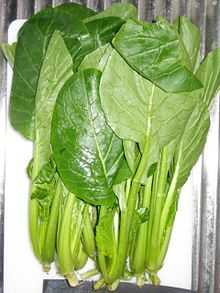Komatsuna
| Komatsuna | |
|---|---|
 | |
| Scientific classification | |
| Kingdom: | Plantae |
| (unranked): | Angiosperms |
| (unranked): | Eudicots |
| (unranked): | Rosids |
| Order: | Brassicales |
| Family: | Brassicaceae |
| Genus: | Brassica |
| Species: | Brassica rapa |
| Variety: | B. rapa var. perviridis |
| Trinomial name | |
| Brassica rapa var. perviridis | |
| Nutritional value per 100 g (3.5 oz) | |
|---|---|
| Energy | 92 kJ (22 kcal) |
|
3.9 g | |
| Dietary fiber | 2.8 g |
|
0.3 g | |
|
2.2 g | |
| Vitamins | |
| Vitamin A equiv. |
(62%) 495 μg |
| Thiamine (B1) |
(6%) 0.068 mg |
| Riboflavin (B2) |
(8%) 0.093 mg |
| Niacin (B3) |
(5%) 0.678 mg |
|
(4%) 0.178 mg | |
| Vitamin B6 |
(12%) 0.153 mg |
| Folate (B9) |
(40%) 159 μg |
| Vitamin C |
(157%) 130 mg |
| Trace metals | |
| Calcium |
(21%) 210 mg |
| Iron |
(12%) 1.5 mg |
| Magnesium |
(3%) 11 mg |
| Manganese |
(19%) 0.407 mg |
| Phosphorus |
(4%) 28 mg |
| Potassium |
(10%) 449 mg |
| Sodium |
(1%) 21 mg |
| Zinc |
(2%) 0.17 mg |
|
| |
| |
|
Percentages are roughly approximated using US recommendations for adults. Source: USDA Nutrient Database | |
Komatsuna (コマツナ(小松菜)?)
or Japanese mustard spinach (Brassica rapa var. perviridis) is a leaf vegetable. It is a variety of Brassica rapa, the plant species that yields the turnip, mizuna, napa cabbage, and rapini. It is grown commercially in Japan and Taiwan. The name komatsuna is from the Japanese komatsuna (小松菜, コマツナ), "small pine tree greens". It is stir-fried, pickled, boiled, and added to soups or used fresh in salads. It is an excellent source of calcium.[1]
The leaves of komatsuna may be eaten at any stage of their growth. In a mature plant they are dark green with slender light green stalks, around 30 centimeters (12") long and 18 cm (7") wide. It is most often grown in the spring and autumn, as it cannot endure extreme heat or cold for more than a short time.
The plant is also used for fodder in some Asian countries.
See also
References
- ↑ Queensland Government, Department of Primary Industries and Fisheries. ""Komatsuna: Commercial Production."". Retrieved 2010.